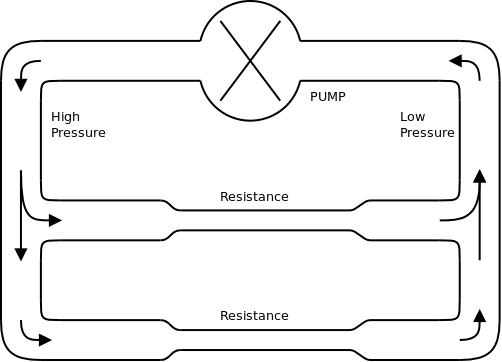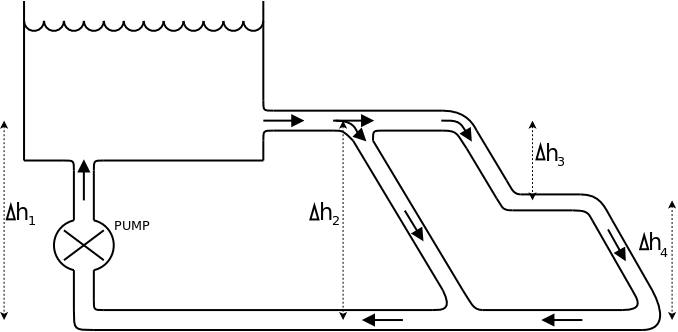The aim of this page is to understand current and voltage at a physical level and get a feel for what is actually going on in an electrical circuit and to also appreciate some of the analogies used to help us think about current and voltage. Although a physical description of current and voltage is not strictly necessary to study electronics, it is much easier to deal with series and parallel circuits and calculate component values with a good intuitive grasp of the underlying concepts. As it is hard to visualise current and voltage, analogies are often used to describe these concepts. When using analogies it is important to consider the limitations of each analogy to avoid misunderstanding.
Current is to do with the rate of flow of charge. This means current tells us how much charge is passing any point in the circuit each second. The charge carriers in an electrical circuit are the electrons in the metal wires, it is these electrons that actually move around the circuit. Each electron has a minute quantity of charge (1.6 × 10-19 C). As the charge on each electron is very small there must be an enormous number of electrons moving round the circuit, therefore, to keep the numbers simple, current is not the number of electrons passing a point in the circuit each second. Current is the amount of charge (measured in coulombs) passing a point in the circuit each second.
Current = total charge that has passed a point ÷ time taken
or
UNITS:
Current is measured in Amps using an ammeter. In electronics an Amp is quite a large current and so smaller units are commonly used:
Charge is conserved – you can not lose or gain charge as it moves around a circuit. This gives us Kirchhoff's current law: The current flowing into a point in a circuit is the same as the current flowing out of that point.

In the diagram, 5 A flows in to the component and 5 A flows out of the component - if this was not the case then the difference in the number of charge carriers entering and leaving the component would be hard to explain leading to either an excess of deficit of charge carriers in the component - a situation that would not last very long! Therefore, it is safe to say that, at all points in a series circuit, the current is the same.

Kirchhoff's current law applied to a parallel circuit: The total current flowing into a junction is equal to the current flowing out of the junction.
The currents in each branch all add up to give the total current before the junction.
In the diagram, a total of 6 A flows into the junction and a total of 6 A (1 + 2 + 3) flows out of the junction. If this was not the case then there would either be a build up or a deficit of charge carriers at the junction which, again, would be an impossible situation.
Voltage is to do with the energy carried around the circuit by the charge carriers. The amount of energy carried by an individual charge carrier is very small so we consider the energy transferred by a whole unit of charge – the coulomb. The amount of energy carried by a coulomb of charge carriers is the voltage.
Voltage = Energy transferred per coulomb of charge
or
UNITS:
Therefore, 1 volt = 1 joule of energy transferred by 1 coulomb of charge,
Voltage is about energy being transferred from one form to another. There are two possible cases where this happens in an electrical circuit:
Electromotive Force (EMF): When energy is transferred from some other form into electrical energy, we call this voltage an EMF. Cells, generators and solar panels have an EMF as they “produce” electrical energy from some other form of energy such as chemical, kinetic or radiant energy
Potential Difference (Pd): When energy is transferred from electrical energy to some other form we call this a potential difference. Bulbs, heaters, loudspeakers have a potential difference across them as they “use” electrical energy – a heater transfers electrical energy to thermal energy
Voltage is measured in volts. In electronics, a volt is a very common reasonable value e.g. a battery produces a few volts. Other units are also used. In audio systems we find mV, in our nervous systems we have µV , power stations use kV and Physics research enjoys MV.
Energy is conserved. The energy total transferred into electrical energy (EMF) must equal the total energy transferred from electrical energy (Pd) in any given complete path around a circuit. A path around the circuit is any continuous route that ends up where it started - on a circuit diagram, start at one point and trace out a path with your finger to get back to that point - this is one particular path.

Kirchhoff's Voltage Law: For any complete path around a circuit, the total EMF is equal to the total Pd across all the components.
In this case the total EMF is the individual EMF of each cell in the battery which all add up to 7 volts. The total Pd is the sum of the individual Pd's across each bulb - again, 7 volts. The energy gained by the charge carriers in going through the battery must be converted to heat and light in the bulbs. In summary, the voltages across all the bulbs adds up to the voltage across the cells. Note that the voltage across each bulb does not have to be the same – it does not have to divide equally. Finally notice that in the last sentence, voltage can be used to mean either EMF of Pd and is the more usual terminology.

In path 1 in the diagram, the EMF of 3 V is matched by a Pd of 3 V across the first bulb.
In path 2, the same situation occurs and the 3 V EMF of the battery is equal to the 3 V Pd across the second (lower) bulb.
Therefore, the Pd across each bulb MUST be the same. In a parallel circuit, whichever path charge carriers go down, they must transfer the same amount of energy. Therefore, in a parallel circuit, the voltages are all the same.
Voltages across two components in PARALLEL are always the same.
Although the Pd across each bulb must be the same, the current through each can be different.
 This analogy considers water flowing through pipes to make a water circuit, this is similar to the water circuit in a central heating system.
This analogy considers water flowing through pipes to make a water circuit, this is similar to the water circuit in a central heating system.
Analogy: The water being pumped round a network of pipes is like electrical current flowing around a circuit. A pump increases the water pressure in the pipes and causes the water to move. Radiators and valves prevent the water from flowing. The pressure difference from one side of the pump to the other is analogous to the EMF of the cell and is what causes the water to flow around the circuit. As water flows through the radiators or other restrictions there is a drop in the water pressure analogous to the Pd across a bulb. The water flowing around the circuit is analogous to current in an electrical circuit. It divides at a junction and then comes back together neatly illustrating how electrical current behaves at a junction. The water current is measured in litres per second just as the electrical current is measured in Coulombs per second.
Good For: Understanding current flow in series and parallel circuits
Analogies:
 In this analogy water pumped up to a height and then flows back back down hill, this is like the water ride at an amusement park.
In this analogy water pumped up to a height and then flows back back down hill, this is like the water ride at an amusement park.
Analogy: Water is pumped up to a height gaining potential energy which is analogous to charge carriers going through a cell gaining electrical energy. The height represents the ‘voltage’. Water flowing downhill gains kinetic energy but loses height which is analogous to electrical energy being transferred to some other form. Water flowing along a level channel loses no height just as current through a wire does result in a significant potential difference.
This analogy shows how voltages relate to each other. Which ever route the water takes, the gain in height is equal to the loss of height around a complete circuit loop. In the diagram we see:
Δh1 = Δh2 (EMF = Potential Difference)
Δh1 = Δh3 + Δh4 (Voltages in series add up)
Good For: Understanding EMF and Potential difference in series and parallel.
Analogies:
Coal trucks driving along roads between a coal mine and several factories or homes dropping off coal along the way.
Analogy: A Coal mine provides coal. This is transported by road to different factories etc. Each factory uses some of the coal and the trucks return to the mine empty ready to be filled up and start a new circuit. The number of trucks passing a point each second can be counted and the amount of coal in each truck measured.
Good For: Understanding potential and current, nature of charge carriers
Analogies:
Students walking around a pretend circuit in a classroom.
Analogy: Students representing charge carriers are only allowed to walk along a set route. One student represents the cell and has a big bucket of sweets which they give out as the moving students representing the charge carriers come past. Other students are bulbs or resistors and collect sweets as "payment" for allowing the charge carrier students to pass. The remaining students who are the charge carriers carry the sweets from one part of the room to another but do not get to keep the sweets. There may be more than one route for a parallel circuit and, as the students represent the negatively charged electrons, they must remain equidistant from each other i.e. spread evenly around the circuit.
Good For: Understanding voltage and current and why cells go flat
Analogies:
There is a video of the different analogies (link at top of page) but it is quite long at just over 20 minutes. It took several goes to get the explanations right and even now I am not totally happy with all of it. The message here is treat analogies with a pinch of salt and don't read too much into them - they make an excellent discussion point. The water circuit starts at 0:16, the second water analogy at 4:03, the coal trucks at 8:49 and the student analogy at 15:53.
© Paul Nicholls
February 2015